初识springcloud以及其代理详解
Posted 一只猪的思考
tags:
篇首语:本文由小常识网(cha138.com)小编为大家整理,主要介绍了初识springcloud以及其代理详解相关的知识,希望对你有一定的参考价值。
一.初识springcloud
1.架构演变

2.什么是微服务架构
- "微服务”一词源于 Martin Fowler的名为 Microservices 的博文,可以在他的官方博客上找到http://martinfowler.com/articles/microservices.html
- 微服务是系统架构上的一种设计风格,它的主旨是将一个原本独立的系统拆分成多个小型服务,这些小型服务都在各自独立的进程中运行,服务之间一般通过 HTTP 的 RESTfuL API 进行通信协作。
- 被拆分成的每一个小型服务都围绕着系统中的某一项或些耦合度较高的业务功能进行构建,并且每个服务都维护着白身的数据存储、业务开发自动化测试案例以及独立部署机制。
- 由于有了轻量级的通信协作基础,所以这些微服务可以使用不同的语言来编写。
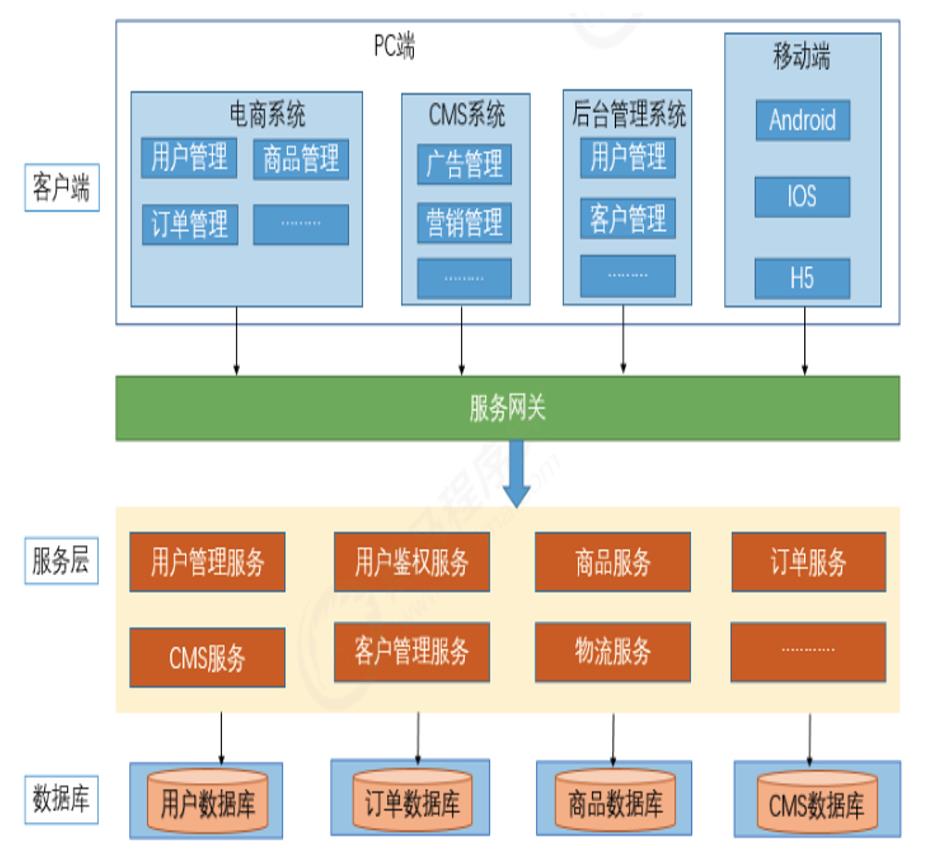
二.走进springcloud
- Spring Cloud 是一系列框架的有序集合。
- Spring Cloud 并没有
重复制造轮子,它只是将目前各家公司开发的比较成熟、经得起实际考验的服务框架组合起来。 - 通过 Spring Boot 风格进行再封装屏蔽掉了复杂的配置和实现原理,最终给开发者留出了一套
简单易懂、易部署和易维护的分布式系统开发工具包。 - 它利用Spring Boot的开发便利性巧妙地简化了分布式系统基础设施的开发,如服务发现
注册、配置中心、消息总线、负载均衡、断路器、数据监控等,都可以用Spring Boot的开发风格做到一键启动和部署。 - Spring Cloud项目官方网址:https://spring.io/projects/spring-cloud
- Spring Cloud 版本命名方式采用了
伦敦地铁站的名称,同时根据字母表的顺序来对应版本时间顺序,比如:最早的Release版本:Angel,第二个 Release版本:Brixton,然后是Camden、Dalston、Edgware,Finchley,Greenwich,Hoxton。- 目前最新的是Hoxton版本。
三.Spring Cloud 与 Dubbo 对比
- Spring Cloud 与 Dubbo 都是实现微服务有效的工具。
- Dubbo 只是实现了服务治理,而 Spring Cloud 子项目分别覆盖了微服务架构下的众多部件。
- Dubbo 使用 RPC 通讯协议,Spring Cloud 使用 RESTful 完成通信,Dubbo 效率略高于 Spring Cloud。
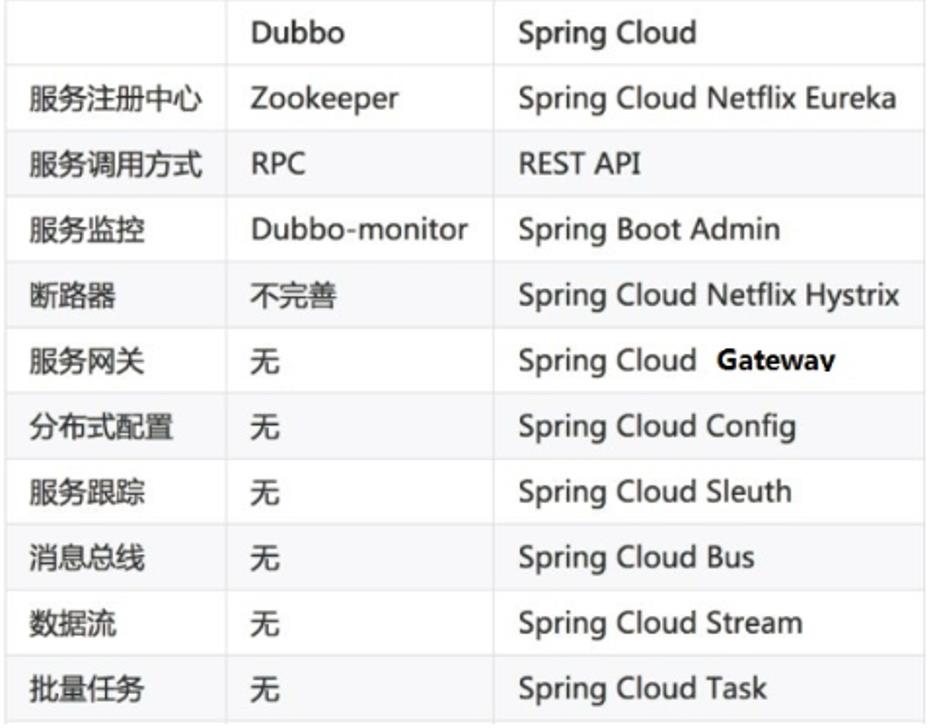
小结:
- 微服务就是将项目的各个模块拆分为可独立运行、部署、测试的架构设计风格。
- Spring 公司将其他公司中微服务架构常用的组件整合起来,并使用 SpringBoot 简化其开发、配置。称为 Spring Cloud
- Spring Cloud 与 Dubbo都是实现微服务有效的工具。Dubbo 性能更好,而 Spring Cloud 功能更全面。
四.Spring Cloud 服务治理
1.eureka
-
搭建 Provider 和 Consumer 服务。
-
使用 RestTemplate 完成远程调用。
Spring提供的一种简单便捷的模板类,用于在 java 代码里访问 restful 服务。
其功能与 HttpClient 类似,但是 RestTemplate 实现更优雅,使用更方便。
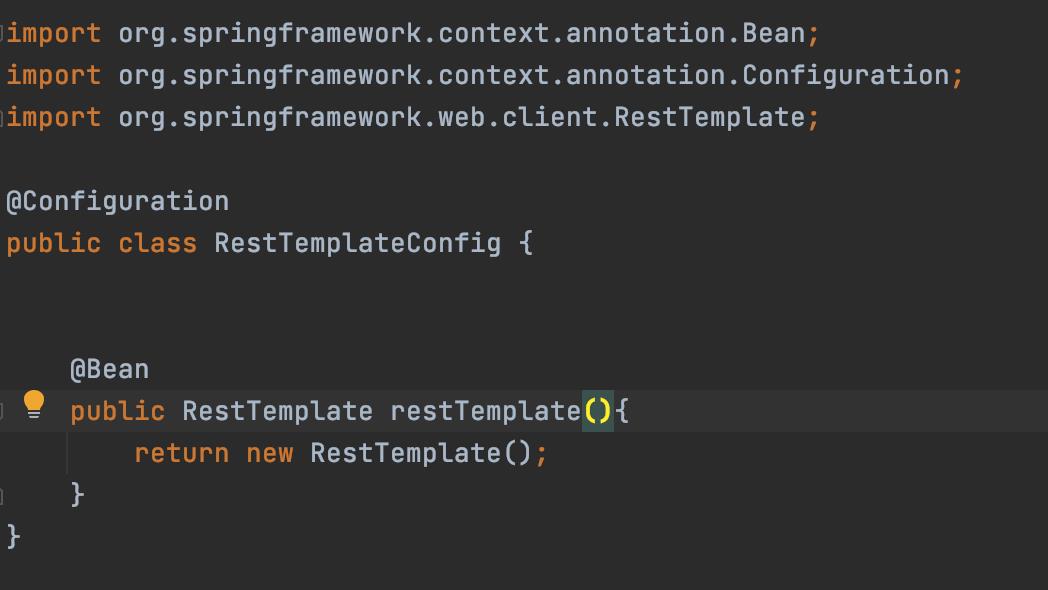
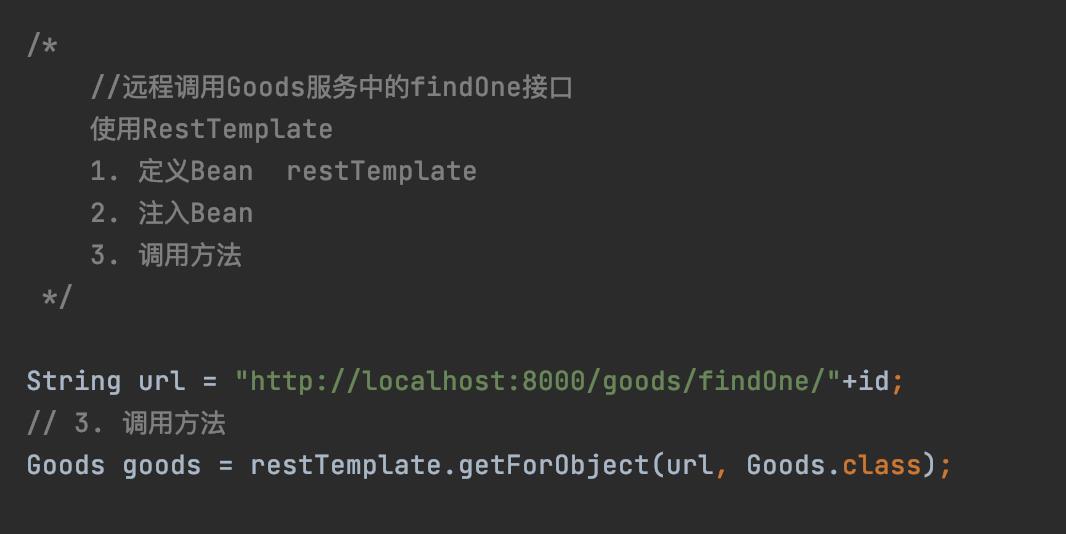
- 搭建 Eureka Server 服务。
(1)创建 eureka-server 模块
(2)引入 SpringCloud 和 euraka-server 相关依赖
<dependencies>
<dependency>
<groupId>org.springframework.boot</groupId>
<artifactId>spring-boot-starter-web</artifactId>
</dependency>
<!-- eureka-server -->
<dependency>
<groupId>org.springframework.cloud</groupId>
<artifactId>spring-cloud-starter-netflix-eureka-server</artifactId>
</dependency>
</dependencies>
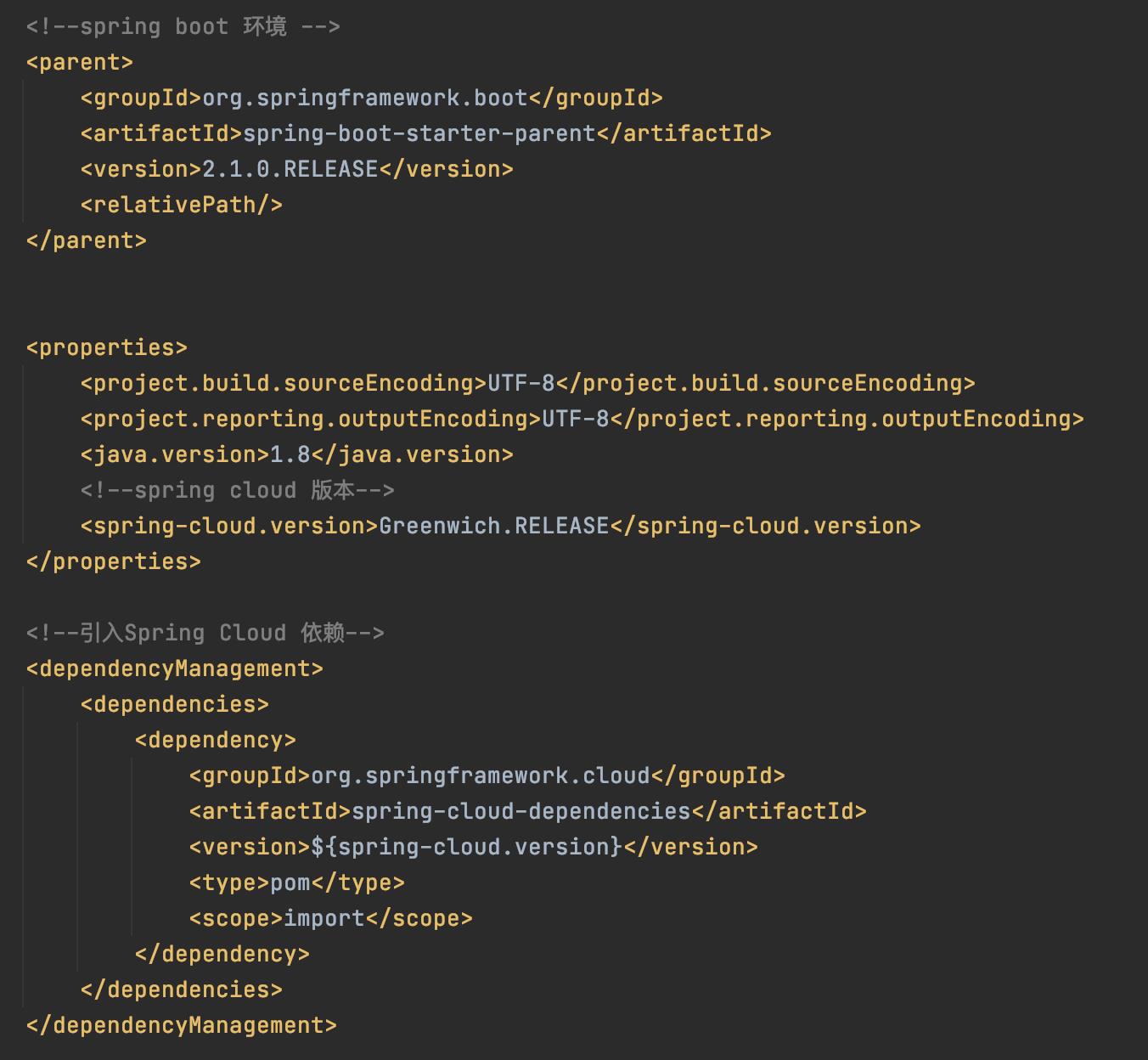
(3)完成 Eureka Server 相关配置
application.yml配置:
server:
port: 8761
# eureka 配置
# eureka 一共有4部分 配置
# 1. dashboard:eureka的web控制台配置
# 2. server:eureka的服务端配置
# 3. client:eureka的客户端配置
# 4. instance:eureka的实例配置
eureka:
instance:
hostname: localhost # 主机名
client:
service-url:
defaultZone: http://${eureka.instance.hostname}:${server.port}/eureka # eureka服务端地址,将来客户端使用该地址和eureka进行通信
register-with-eureka: false # 是否将自己的路径 注册到eureka上。eureka server 不需要的,eureka provider client 需要
fetch-registry: false # 是否需要从eureka中抓取路径。eureka server 不需要的,eureka consumer client 需要
启动类配置

(4)启动该模块
- 改造 Provider 和 Consumer 称为 Eureka Client。
consumer配置:
application.yml
server:
port: 9000
eureka:
instance:
hostname: localhost # 主机名
client:
service-url:
defaultZone: http://localhost:8761/eureka # eureka服务端地址,将来客户端使用该地址和eureka进行通信
spring:
application:
name: eureka-consumer # 设置当前应用的名称。将来会在eureka中Application显示。将来需要使用该名称来获取路径
controller
@RestController
@RequestMapping("/order")
public class OrderController {
@Autowired
private RestTemplate restTemplate;
@Autowired
private DiscoveryClient discoveryClient;
@GetMapping("/goods/{id}")
public Goods findGoodsById(@PathVariable("id") int id){
System.out.println("findGoodsById..."+id);
/*
//远程调用Goods服务中的findOne接口
使用RestTemplate
1. 定义Bean restTemplate
2. 注入Bean
3. 调用方法
*/
/*
动态从Eureka Server 中获取 provider 的 ip 和端口
1. 注入 DiscoveryClient 对象.激活
2. 调用方法
*/
//演示discoveryClient 使用
List<ServiceInstance> instances = discoveryClient.getInstances("EUREKA-PROVIDER");
//判断集合是否有数据
if(instances == null || instances.size() == 0){
//集合没有数据
return null;
}
ServiceInstance instance = instances.get(0);
String host = instance.getHost();//获取ip
int port = instance.getPort();//获取端口
System.out.println(host);
System.out.println(port);
String url = "http://"+host+":"+port+"/goods/findOne/"+id;
// 3. 调用方法
Goods goods = restTemplate.getForObject(url, Goods.class);
return goods;
}
}
pom
<dependencies>
<!--spring boot web-->
<dependency>
<groupId>org.springframework.boot</groupId>
<artifactId>spring-boot-starter-web</artifactId>
</dependency>
<!-- eureka-client -->
<dependency>
<groupId>org.springframework.cloud</groupId>
<artifactId>spring-cloud-starter-netflix-eureka-client</artifactId>
</dependency>
</dependencies>
provider配置:
application.yml
server:
port: 8001
eureka:
instance:
hostname: localhost # 主机名
client:
service-url:
defaultZone: http://localhost:8761/eureka # eureka服务端地址,将来客户端使用该地址和eureka进行通信
spring:
application:
name: eureka-provider # 设置当前应用的名称。将来会在eureka中Application显示。将来需要使用该名称来获取路径
controller
//演示discoveryClient 使用
List<ServiceInstance> instances = discoveryClient.getInstances("EUREKA-PROVIDER");
//判断集合是否有数据
if(instances == null || instances.size() == 0){
//集合没有数据
return null;
}
ServiceInstance instance = instances.get(0);
String host = instance.getHost();//获取ip
int port = instance.getPort();//获取端口
System.out.println(host);
System.out.println(port);
String url = "http://"+host+":"+port+"/goods/findOne/"+id;
// 3. 调用方法
Goods goods = restTemplate.getForObject(url, Goods.class);
pom
<dependencies>
<!--spring boot web-->
<dependency>
<groupId>org.springframework.boot</groupId>
<artifactId>spring-boot-starter-web</artifactId>
</dependency>
<!-- eureka-client -->
<dependency>
<groupId>org.springframework.cloud</groupId>
<artifactId>spring-cloud-starter-netflix-eureka-client</artifactId>
</dependency>
</dependencies>
- Consumer 服务 通过从 Eureka Server 中抓取 Provider 地址 完成 远程调用
@RestController
@RequestMapping("/goods")
public class GoodsController {
@Autowired
private GoodsService goodsService;
@GetMapping("/findOne/{id}")
public Goods findOne(@PathVariable("id") int id){
Goods goods = goodsService.findOne(id);
return goods;
}
}
启动类记得添加@EnableDiscoveryClient // 激活DiscoveryClient
Eureka – 相关配置及特性
eureka 一共有4部分 配置
- server : eureka 的服务端配置
- client : eureka 的客户端配置
- instance : eureka 的实例配置
- dashboard : eureka 的web控制台配置
==Eureka – 相关配置及特性 - instance ==

Eureka – 相关配置及特性 - server
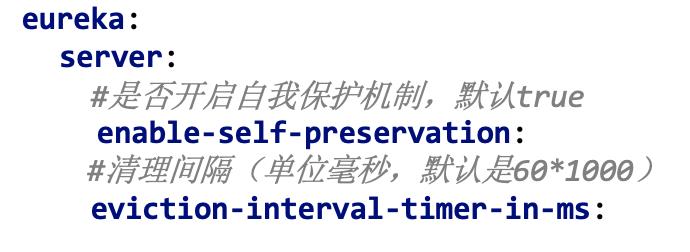

Eureka – 相关配置及特性 - client

Eureka – 相关配置及特性 - dashboard

Eureka – 高可用
-
准备两个Eureka Server
-
分别进行配置,相互注册

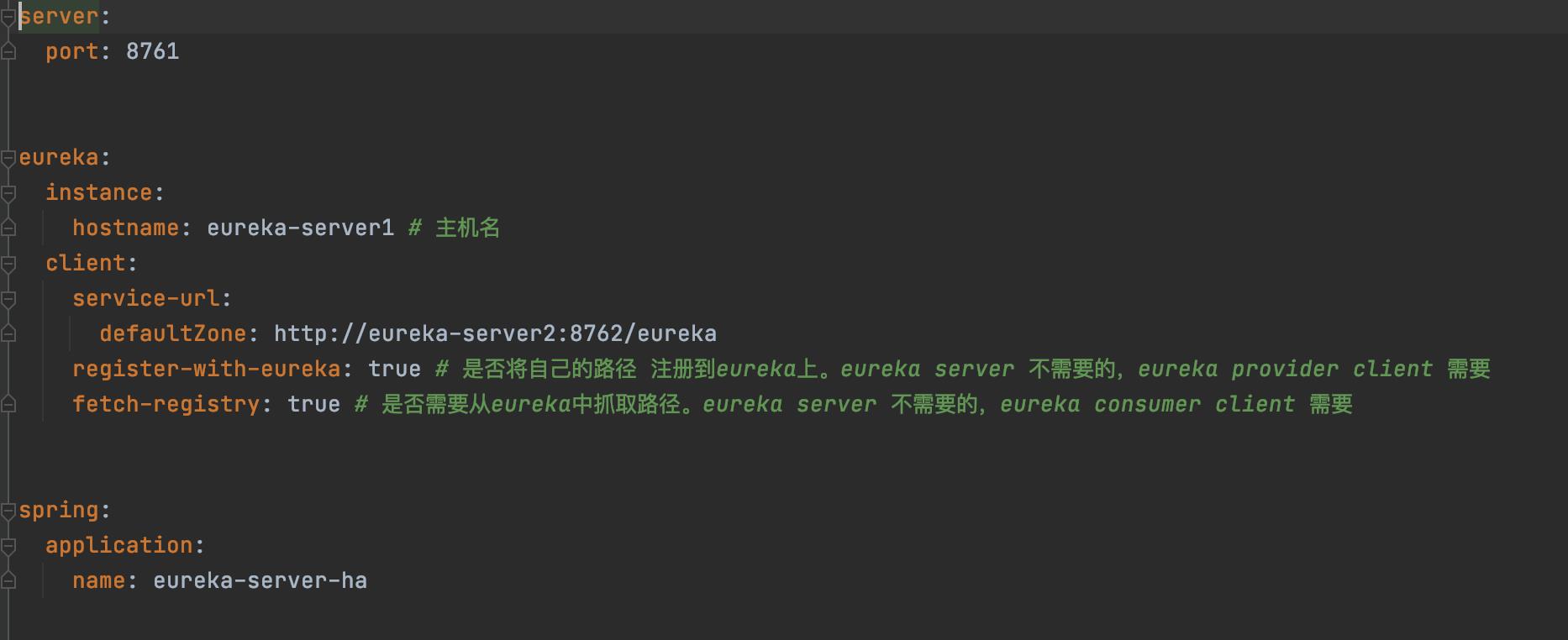
-
Eureka Client 分别注册到这两个 Eureka Server中
server:
port: 9000
eureka:
instance:
hostname: localhost # 主机名
client:
service-url:
defaultZone: http://eureka-server1:8761/eureka,http://eureka-server2:8762/eureka # eureka服务端地址,将来客户端使用该地址和eureka进行通信
spring:
application:
name: eureka-consumer # 设置当前应用的名称。将来会在eureka中Application显示。将来需要使用该名称来获取路径
2.Consul
简介
- Consul 是由 HashiCorp 基于 Go 语言开发的,支持多数据中心,分布式高可用的服务发布和注册服务软件。
- 用于实现分布式系统的服务发现与配置。
- 使用起来也较 为简单。具有天然可移植性(支持Linux、windows和Mac OS X);安装包仅包含一个可执行文件,方便部署 。
- 官网地址: https://www.consul.io
使用方法
搭建 Provider 和 Consumer 服务。
使用 RestTemplate 完成远程调用。
将Provider服务注册到Consul中。
provider
server:
port: 8000
spring:
cloud:
consul:
host: localhost # consul 服务端的 ip
port: 8500 # consul 服务端的端口 默认8500
discovery:
service-name: ${spring.application.name} # 当前应用注册到consul的名称
prefer-ip-address: true # 注册ip
application:
name: consul-provider # 应用名称
consumer
server:
port: 9000
spring:
cloud:
consul:
host: localhost # consul 服务端的 ip
port: 8500 # consul 服务端的端口 默认8500
discovery:
service-name: ${spring.application.name} # 当前应用注册到consul的名称
prefer-ip-address: true # 注册ip
application:
name: consul-consumer # 应用名称
pom.xml
<dependencies>
<!--consul 客户端-->
<dependency>
<groupId>org.springframework.cloud</groupId>
<artifactId>spring-cloud-starter-consul-discovery</artifactId>
</dependency>
<dependency>
<groupId>org.springframework.boot</groupId>
<artifactId>spring-boot-starter-web</artifactId>
</dependency>
<dependency>
<groupId>org.springframework.boot</groupId>
<artifactId>spring-boot-starter-test</artifactId>
<scope>test</scope>
</dependency>
<dependency>
<groupId>org.springframework.boot</groupId>
<artifactId>spring-boot-starter-actuator</artifactId>
</dependency>
</dependencies>
Consumer 服务 通过从 Consul 中抓取 Provider 地址 完成 远程调用
具体步骤参考eureka
3.Nacos
- Nacos(Dynamic Naming and Configuration Service) 是阿里巴巴2018年7月开源的项目。
- 它专注于服务发现和配置管理领域 致力于帮助您发现、配置和管理微服务。Nacos 支持几乎所有主流类型的“服务”的发现、配置和管理。
- 一句话概括就是Nacos = Spring Cloud注册中心 + Spring Cloud配置中心。
- 官网:https://nacos.io/
- 下载地址:https://github.com/alibaba/nacos/releases
使用方法宇consul基本一致
只需要更改application.yml和pom.xml
application.yml
consumer
server:
port: 9000
spring:
cloud:
nacos:
discovery:
server-addr: 127.0.0.1:8848 # 配置nacos 服务端地址
application:
name: nacos-consumer # 服务名称
provider
server:
port: 8000
spring:
cloud:
nacos:
discovery:
server-addr: 127.0.0.1:8848 # 配置nacos 服务端地址
application:
name: nacos-provider # 服务名称
pom.xml
<!--nacos-->
<dependency>
<groupId>org.springframework.cloud</groupId>
<artifactId>spring-cloud-starter-alibaba-nacos-discovery</artifactId>
<version>0.2.2.RELEASE</version>
</dependency>
<dependency>
<groupId>com.alibaba.nacos</groupId>
<artifactId>nacos-client</artifactId>
<version>1.1.0</version>
</dependency>
<dependency>
<groupId>org.springframework.boot</groupId>
<artifactId>spring-boot-starter-web</artifactId>
</dependency>
<dependency>
<groupId>org.springframework.boot</groupId>
<artifactId>spring-boot-starter-test</artifactId>
<scope>test</scope>
</dependency>
<dependency>
<groupId>org.springframework.boot</groupId>
<artifactId>spring-boot-starter-actuator</artifactId>
</dependency>
以上是关于初识springcloud以及其代理详解的主要内容,如果未能解决你的问题,请参考以下文章
